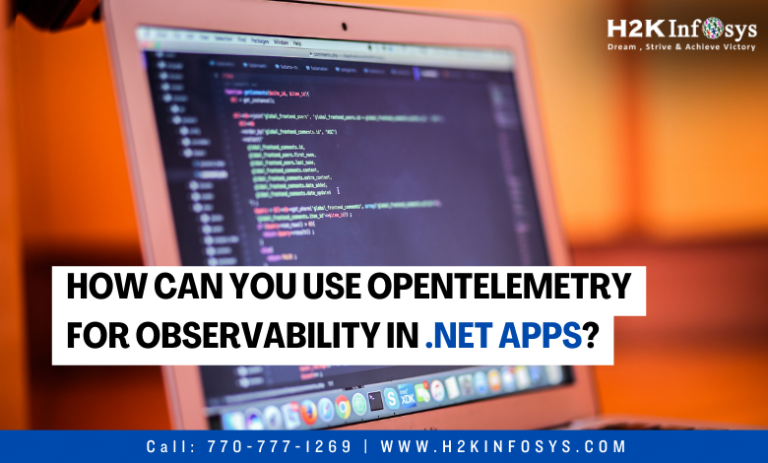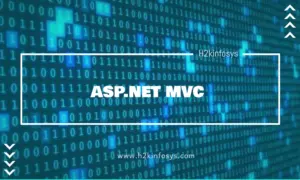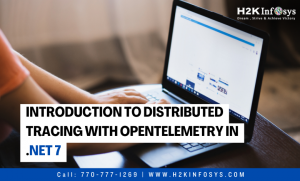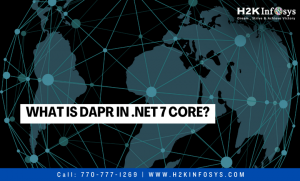It is likely that you’re using Microsoft’s .NET framework if you’re building enterprise-level applications. A modern distributed cloud-native application will benefit from being instrumented for comprehensive observability via OpenTelemetry, even though the framework and the tools created for it already have some powerful reliability, monitoring, and performance optimization features.
OTel, an open source observability framework, gathers, examines, and exports telemetry data to assist in closely monitoring your system. As a project of the Cloud Native Computing Foundation (CNCF), it comes with software development kits for a variety of frameworks and languages, including .NET.
In this article, you will learn how OpenTelemetry works with respect to .NET apps. Check out our .NET online training to learn more.
How does OpenTelemetry in .NET Works?
For the purpose of instrumentation signal capture and smooth application interaction, OpenTelemetry offers both SDKs and APIs. After then, these signals are sent to the OpenTelemetry Collector, an essential part of the system.
Telemetry data is received, processed, and exported by the collector. “Receivers,” “processors,” and “exporters” make up this system.
- Instrumentation data is sent to receivers from a variety of sources, such as SQL, gRPC, HttpClients, and application services.
- After receiving data from receivers, processors conduct changes such as batching, filtering, or enriching with more data pieces. (OpenTelemetry suggests limiting the number of CPUs you use.)
- The processed data is sent by exporters to different backends for analysis, display, and storage.
- The systems like Prometheus, Zipkin, and Grafana that accept data from OpenTelemetry are known as backends.
OpenTelemetry Signals
Three kinds of signals are released by OpenTelemetry:
- Within your application, Traces show a request’s whole lifecycle. They are recognized by a SpanId and are made up of spans identified by a TraceId. Single operations inside a particular trace are called spans.
- Units of measurement used in runtime are called Metrics. A wide range of service characteristics, such as availability and request volume, can be explained by them.
- Logs are text documents with metadata and a time stamp. They provide data such as warnings, errors, and debugging events. In OpenTelemetry, a structured log with extra metadata, such as TraceId, SpanId, and attributes, is called a `LogRecord}.
The OpenTelemetry .NET SDK
A collection of APIs for signal formats, including span, characteristics, and metric values, are defined by OpenTelemetry. It does not, however, outline the process for exporting or sampling these signals. No-op implementations are the name given to these kinds of APIs. These APIs are replaced with concrete implementations that offer the actual capability for sampling and exporting using OpenTelemetry SDKs.
Best Practices for Leveraging OpenTelemetry in .NET
The following best practices will help you get the most out of OpenTelemetry in a C# environment:
1.Use Automated Instrumentation
To prevent manual code adjustments, use auto instrumentation to get metrics and traces from your apps. Version 4.6.2 or higher of the .NET Framework is needed for this. The operating system-specific installation script must also be executed.
2.Adhere to Semantic Guidelines
To assure consistency and speed up data analysis, create a uniform naming scheme using semantic rules for your telemetry data.
3.Monitor OpenTelemetry Performance
Keep a close eye on how OpenTelemetry is affecting the functionality of your application. Latency or other types of performance degradation may be increased.
To further enhance performance, think about batching. By sending several spans or metrics in a single request, you can lower the quantity of outgoing calls.
4.Make Sure You Have Complete Instrumentation
Make sure that every component required to collect pertinent data is instrumented. Gaps in the data can result from inconsistent or incomplete equipment, which makes analysis difficult.
Several tips to improve your instrumentation data are as follows:
- Propagate context: Make sure that the instrumentation data propagates all required information from the request, such as the IP address and user ID.
- Instrument all service: To prevent blind spots in your telemetry data, be sure to instrument all of your services, including those provided by outside parties.
- Review instrumentation data on a regular basis: You’ll probably add more data to your program as it expands and develops, which will allow you to further enhance the instrumentation.
- Make sure all of your traces, logs, and metrics have consistent names: For efficient data correlation during analysis, this is essential.
5.Mind the Exporter Configuration
Keep a close eye on the configurations of your exporters to avoid problems like data duplication or misconfigured data loss. When setting up your exporter, bear the following points in mind:
- Make sure the exporter you select is appropriate for your backend service. For example, an exporter for Jaeger won’t function with a Zipkin backend service.
- Set up retrying procedures to handle transient failures, preventing instrumentation loss due to backend or temporary network difficulties.
- If you want to minimise the amount of instrumentation signals exported, think about utilising sampling methods. This is especially crucial for apps with a lot of traffic.
Tips for Efficiently Analysing OpenTelemetry Data
The following advice can help you extract insightful meaning from the information you gather:
- Make use of `TraceIds} and `SpanIds}: to assist you create full end-to-end visibility in your system for a specific request. This will allow you to comprehend the actions the request takes across several system components.
- Use metrics: Metrics from OpenTelemetry can alert you in advance to any problems with your application, including slowly responding to API requests. Use push notifications, SMS, or email to set up pertinent alerts.
- Set metrics in order of importance: It’s possible that your system may produce a large number of metrics, which can be difficult to track and analyse and frequently have no bearing. Determine what is most important to your company and concentrate on that. For example, Does the average user session response time from an API matter.
- Use dashboards: Dashboards provide you with a summary of the various components of your system. Utilise them to lessen the mental strain associated with telemetry data analysis.
Tools and Platforms Compatible with OpenTelemetry
OpenTelemetry data analysis can be done with a number of commercial tools, including:
- Grafana dashboards are well known for being user-friendly. It provides real-time metrics visualisations through a smooth integration with Prometheus.
- Grafana is frequently used in conjunction with Prometheus, a potent monitoring and alerting toolkit, to provide improved visualisation capabilities.
- As a component of the Elastic Stack, Kibana (Elastic Stack) has strong querying capabilities and is an excellent logger for data analysis and visualisation.
- In the field of log management, Splunk is a pioneer. It offers a sizable integration library along with sophisticated analytics tools.
- Application performance monitoring (APM), infrastructure monitoring, and log management are all combined into one observability platform called New Relic.
When selecting a tool, take into account your infrastructure’s unique requirements, the degree of data granularity you need, and the degree of customization and integration that each platform can provide. Effective use of these technologies can yield insightful information that will support SRE teams in proactively addressing problems, enhancing performance, and guaranteeing system reliability.
Conclusion One set of APIs made available through the SDK allows you to achieve unified observability when integrating OpenTelemetry into your .NET applications. Check out our Microsoft .NET online certification training to learn more.





























